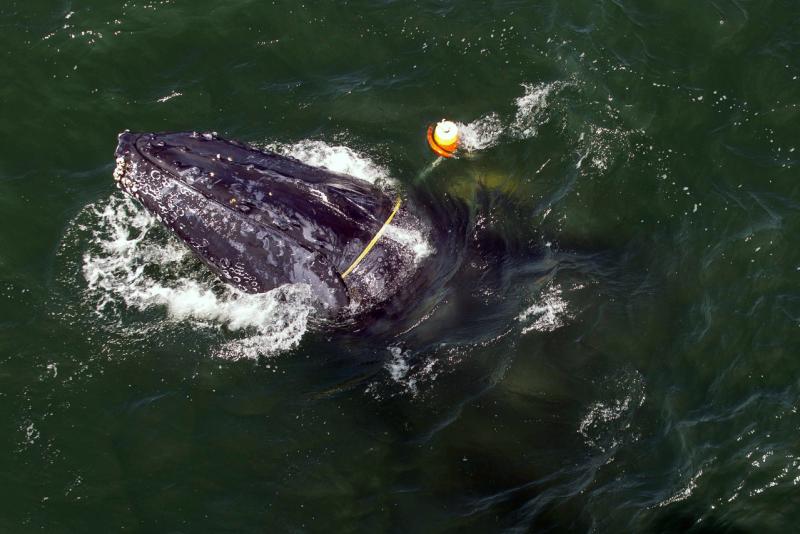Editor's Note: About five years ago a large marine heatwave that became known as “The Blob” took hold in the Pacific Ocean off the West Coast. This is the second installment of a three-part series about "The Blob" and a changing ocean, and what it may mean for the future of the California Current Ecosystem.
Many West Coast Dungeness crab fishermen once fished for salmon. But with sharp ups and downs in salmon returns, they switched to the more dependable Dungeness crab fishery. With harmful algal blooms driving unprecedented delays, “now they see that’s not reliable either,” said Nate Mantua of the Southwest Fisheries Science Center.
The California crab fishery finally opened in April 2016 as the algal toxins waned. The swelling crab fleet wasted no time to go fishing, and deployed thousands of crab pots—also called traps—to make up for lost time.
That also turned out to be the peak in the migration of gray and humpback whales north. Given the unusual temperatures brought by the Blob, the whales that typically feed in deeper water were instead feeding closer to shore, above the continental shelf, Mantua said.
Right where crab fishermen traditionally set their gear.
“It was a perfect storm of events that we did not recognize right away,” said Jarrod Santora, a research biologist at NOAA Fisheries’ Southwest Fisheries Science Center who tracks ocean conditions and their effects on fisheries.
The next year would see more whales than ever on the West Coast become entangled in fishing lines. In those cases where the source of the lines could be determined, three-quarters were from the Dungeness crab fishery.
Piecing the Picture Together
That unfortunate timing underscores the need for improved monitoring and understanding of how the California Current Ecosystem is changing. We also need to understand how those changes may affect species throughout the food web, Mantua said.
“Different fisheries are looking at the world through different lenses, and we have to try to put that picture together,” he said. The challenge now, he said, is for the region to better incorporate the latest ecosystem conditions in decisions on fisheries. These decisions may turn out to have unexpected impacts in surprising places.
NOAA Fisheries’ increased focus on ecosystem-based fishery management will help do that, he noted. For example, the agency’s two West Coast research laboratories regularly assess the state of the California Current Ecosystem. They explain how ongoing environmental change affects both marine species and West Coast communities.

Fishermen, scientists, and others have formed working groups in each West Coast state to reduce the risk of whale entanglements. They are exploring new technology, such as crab traps without lines. Instead, they pop to the surface on command by filling attached floats with compressed air. The California working group has also developed a Risk Assessment and Mitigation Program. It regularly assesses the risk of entanglements based on near real-time information from aerial overflights and other ocean monitoring tools.
Researchers at NOAA Fisheries’ Southwest Fisheries Science Center developed a system called EcoCast. Based on ocean conditions, it projects where fishermen are most likely to catch their target fish but least likely to entangle protected species such as whales and sea turtles. An experimental model that predicts the locations of blue whales off the West Coast is now in development. It may soon provide real-time information to help reduce the risk of entanglements and collisions.
“The positive outcome is that communication is now constantly taking place,” Santora said. “It’s all built around a strong partnership to share information and make the most informed decisions we can.”
Preparing for the Unexpected
The tools also represent a step toward ecosystem-based fisheries management, a big-picture approach in which management decisions recognize interactions across the ecosystem. That will become even more imperative with a warming climate and changing ocean, Werner said. NOAA Fisheries regions are also developing action plans under the agency’s Climate Science Strategy to promote responsive management.
“Are we going to get a whole series of blobs, or some other kind of extreme events?” he asked. “The Blob was a wake-up call for us all that we need to prepare ourselves for the unexpected.”
Even as the heat of the Blob faded from the northeast Pacific, the Bering Sea remained remarkably warm. Scientists continue to watch the region carefully, in part because of lessons learned from The Blob, Werner said.
Following his analysis of past marine heatwaves, Leising turned to the future. He used his criteria for the extent, longevity and intensity of a Blob-like heatwave to develop an online tracking tool. It watches for signs that another similar heat wave is emerging. He hopes that will identify any future blob before changes begin cascading through the ecosystem, perhaps in time to make management adjustments. This could reduce the risk of unintended consequences and promote the resilience of the ecosystem.
He notes, though, that climate models project continuing warming of the Pacific in the coming decades. Predictions are that the striking temperatures of The Blob Years become typical.
“At some point, everywhere might look like what we think of today as an anomaly,” he says. “It wouldn’t be anomalous anymore.”




